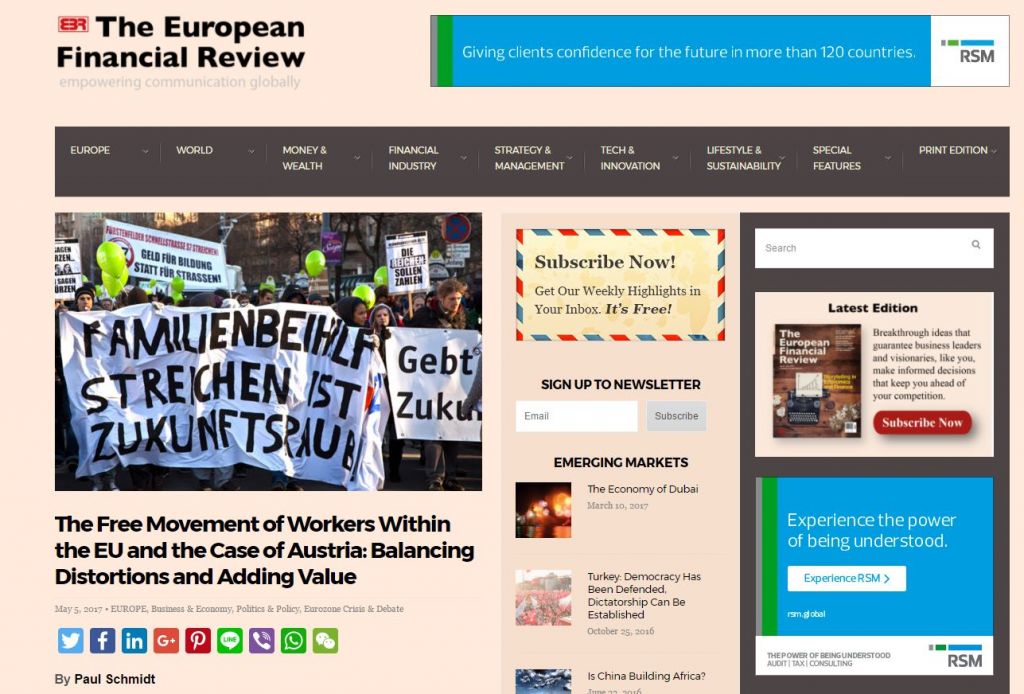As a small, open economy, Austria has clearly benefitted from its EU-membership and is one of the top gainers of the European single market. But the Austrian economy has not yet fully recovered from the past financial crisis. The economic outlook remains modest and unemployment has been rising. Even though economic growth rates have been picking up again from 0.1 percent of GDP in 2013 to around 1.5 percent in 2016, they are still less than half of what they were in 2007. For many years also the performance of the Austrian labour market used to be exemplary in Europe. But since 2008 unemployment has increased by almost 70 percent from 212,300 unemployed persons in 2008 to 357,300 in 2016, which accounts to 9.1 percent of its working population. Nevertheless the attractiveness of the Austrian economy and welfare state has been a strong pull factor for the influx of EU-workers putting additional pressure on the labour market.
In particular over the last decade immigration has increased rapidly. Since 2011 the number of Hungarian, Slovak, Romanian and Bulgarian citizens, for instance, has more than doubled. Compared to other EU countries, Austria has one of the highest levels of immigration. In relative terms, it surpasses Germany, the United Kingdom and France; albeit immigration to “sovereign” Switzerland is still more than a third higher.
Graph 1: Austrian population according to citizenship (selected countries)
Source: Statistik Austria, Statistik des Bevölkerungstandes (Population Statistics)
The main reason for the migration from East to West seems obvious: Even though economic convergence initially – and after the respective EU accessions – developed a strong momentum, partly with growth rates twice as high as in Western Europe, the economic and financial crisis caused a severe slow-down of the catching-up process. Today it is almost surprising that mobility has not advanced much further. In particular when looking at gross hourly dispersion ratios, where Austria with an average gross hourly salary of euro 13,80 is – according to official statistics – still well ahead of countries such as Slovenia (7,30), the Czech Republic (4,60), Slovakia (4,40), Poland (4,30), Hungary (3,60) and especially Romania (2,00) and Bulgaria (1,70). The wage differential becomes even more apparent when looking at the lowest and highest deciles. In Hungary, Bulgaria and Romania the highest decile still earns less than the lowest decile in Austria.
Graph 2: Gross hourly earnings (in euro) in Austria and selected countries
Quelle: Eurostat, SES (earn_ses_hourly)
In addition to immigration, and due to its geographical proximity, an increasing amount of worker postings and commuters needs to be absorbed by the Austrian labour market. Even though basic rights such as minimum remuneration and maximum working hours are applicable, social security contributions, for instance in the case of posted workers, are paid in the sending country. Consequentially, competition is distorted with massive disadvantages also for posted and commuting employees. Critics have emphasized underpayments, double working hours as well as falsified documents.
According to current government estimates 70 per cent of the jobs created in the country are taken by EU-citizens newly entering the labour market. Austria has, thus, repeatedly urged the European Commission to revise the Posted Workers Directive and prioritize employment protection. It has also lobbied for a common consolidated corporate tax base to avoid harmful site competition and a race to the bottom. On the domestic front, the mix of political and economic challenges has led to more target-oriented policies: a reduction in wage costs for companies that generate additional jobs – in particular for people already living in Austria.
The reasoning behind this decision is obvious. But can EU member states create jobs for residents only? At least according to the Austrian government they can. The objective is to reduce unemployment by granting a tax-bonus to companies employing jobless residents.
The employment bonus, adopted by the coalition government at the end of February, plans to reimburse a company for 50 per cent of auxiliary wage costs over three years for every additional job – or full-time equivalent – created. Government earmarks 2 billion euros for this initiative, which shall be evaluated after the first two years. The bonus would be granted for newly created jobs with a duration of at least six months. It is planned to target people, registered as unemployed, wanting to change job or graduates from an Austrian educational establishment as well as third country-citizens holding a special work permit. Companies planning to employ EU citizens, who are not yet living in Austria, would therefore not be entitled to benefit from the bonus-system.
The verdict is still out whether the bonus scheme in its current form will be an effective tool to create reduce unemployment. And while the political case for preferential treatment seems clear, legally Austria could be walking on thin ice. The measure seems feasible and proportional when targeted at people without employment. However, it might be difficult to argue its compatibility with EU-law, when including a wider group of people such as job-changers, holders of a special work-permit or graduates from an Austrian institution. That could be a clear case of discrimination against other EU-citizens. If other countries would follow this example the freedom of movement could be seriously challenged.
As Austria tries to protect its labour market it seems to oversee that it actually benefits not only from the common market, but also from the free movement of workers as such. In fact, the Austrian economy needs immigration. The countries continuous participation in the European integration process led to the creation of 18.500 jobs annually – i.e. accumulated around 480.000 jobs. Similar to other countries EU citizens migrating to Austria to fill newly created jobs are in most cases better educated than people, who are looking for a job in Austria. Industry argues that it is difficult to always recruit the right people from the national work force only, which could in fact impact the economic outlook as well as the willingness of international companies to settle in Austria. Beyond that, in 2015, foreigners working in Austria paid around 4.5 billion euros into the social system, whereas only half of that amount was returned via social benefits. The Austrian tourism industry is a case in point for being able to counter a shortage of skills. And the overnight stays of tourists from the “new” EU-member states have more than doubled since 2005. Furthermore, around 264.000 Austrians do live in other European countries and Austria is also a country, which posts employees to other EU member states – mainly to Germany.
Austria is one of the main investors and exporters in/to Central and Eastern Europe. Funding provided by the EU for these countries is often absorbed by its companies. Above all many local supermarkets, banks and construction companies have been replaced by Austrian equivalents. A development, which is not always very much appreciated in the neighbouring countries either.
It is difficult to disentangle the four European freedoms. But if one of the main foundations of integration is modified, the others will not be held up. Austria’s actions to reduce migration into the labour market might lead neighbouring countries to prevent foreign companies from carrying out business in their countries.
We thus need to strike the right balance between open markets, the fight against unemployment and controlling the – in some areas – needed, but admittedly exaggerated immigration into the respective economies. But cherry picking in a Union of 28 members can be no sustainable solution. A fundamental requirement for a functioning single market is, however, fairness towards employers and employees, compliance with existing rules and the possibility to react if cross-border distortions do occur. Eventually, there is a clear need for decisive European action to revive economic and social convergence in Europe.
Link to the article: http://www.europeanfinancialreview.com/?p=15641








